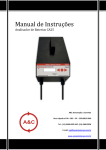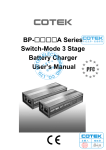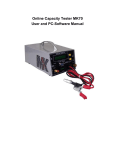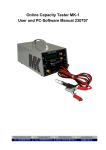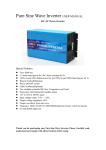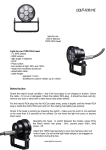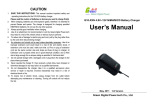Download HAWK OPERATORS MANUAL 2012
Transcript
HAWK OPERATORS MANUAL 2012 HAWK BATTERY OPERATORS MANUAL (1) Battery Status Indicator (2) Press To Test Status Button (3) Charger Input Plug (4) Battery Output Socket (5) Battery Safety Valve (6) Battery Output Fuse 1/ Battery Indicator The battery status indicator informs the operator as to the state of the internal battery condition. When four LED’s are lit on the indicator the battery is between full and 76% charged When three LED’s are lit on the indicator the battery is between 75% and 51% charged When two LED’s are lit on the indicator the battery is between 50% and 26% charged When One LED (Red) is lit on the indicator the battery is between 25% and 10% charged When one LED (Red) is flashing on the indicator the battery is between 9% and 1% charged 2/ Battery Status Press to Test Button Press to test is used to activate the battery indicator. The indicator will remain on for five seconds with the button pressed. 3/ Charger Input Plug The charger input plug is used to charge the battery. 4/ Battery Output Socket The voltage output socket is used to deliver 24 volts DC. A=+ B=- HAWK BATTERY OPERATORS MANUAL (1) Battery Status Indicator (2) Press To Test Status Button (3) Charger Input Plug (4) Battery Output Socket (5) Battery Safety Valve (6) Battery Output Fuse 5/ Battery Safety Valve The battery safety valve is a mechanical backup valve used to allow the battery to gas in the event of an emergency. 6/ Battery Fuse The battery fuse is rated at 12.5 Amps. To replace the fuse turn the fuse holder slot anti-clockwise to access the inner fuse holder. ONLY REPLACE WITH A 12.5 AMP FF FUSE HAWK ELECTRONIC 24VOLT BATTERY Trouble Shooting Battery management is even more crucial in high ambient temperatures. To minimise battery problems in these conditions there is one simple rule. KEEP IT AS COOL AS POSSIBLE This will greatly reduce self-discharge and improve the charging characteristics. Problem Possible Cause Fuse not locked in holder No output from battery Fuse keeps blowing Fuse blown Possible Remedy Check fuse is located correctly Replace 12.5Amp FF Fuse Battery over-heated Allow battery to cool for 1 hour Incorrect fuse fitted Replace with 12.5Amp FF Fuse Short on output lead Replace output lead Equipment pulls over 12.5 amps Use two batteries in parallel Equipment faulty Gas gauge shows red LED flashing only after full charge has been completed Gas gauge shows 3 or less LEDs after full charge *(1) *(2) *(3) *(4) Check equipment *(5) Battery over-heated, causing gas gauge to re-set to zero Allow battery to cool, after which proceed with full discharge then recharge again *(6) Gas gauge out of sync with battery Discharge battery fully, then recharge fully *(7) Allow battery to cool, after which proceed with full discharge, then recharge again *(8) Gas gauge showed all 4 LEDs after full Battery over-heated, causing charge, then after short gas gauge to re-set to zero time, reverted to red flashing only. * Note *(1) The fuse is fitted within a sliding cartridge tray. Twist slotted outer fuse holder anti-clockwise to slide tray out. To replace fuse remove old fuse by lifting out of tray and replace with new 12.5 amp FF. Slide tray back into housing and turn clockwise. *(2) In high ambient temperatures it is possible that the battery could over-heat This will automatically disengage the battery thermal resetable fuse. Once the temperature has cooled sufficiently inside the battery the fuse will re-set. If this does take place the gas gauge will trip out and re-set to zero. Once the battery thermal fuse has re-set, (although the gas gauge is showing a red flashing LED), the battery can still be used as it will be fully charged. If the battery charger is showing a fully charged battery, the battery will be fully charged irrespective of the gas gauge. *(3) Should the output lead be accidentally damaged causing the positive and negative leads to short out this will blow the fuse in the battery. The "HAWK" is protected against this occurrence happening.Once the fuse and lead has been replaced, the "HAWK" will function normally without any damage having been done to the battery. Remember that if this has occurred, the gas gauge will have re-set to zero and will only correct itself on the next charge cycle. *(4) Should the equipment being used require more than 12.5 amps current draw, the only way to resolve this issue is to connect two "HAWK" batteries through a two in one Y lead or junction box, this will increase battery output to 25Ah. *(5) Equipment that the battery is connected to could have developed a fault causing current draw to rise significantly. It must be understood that a battery cannot damage or cause a fuse to blow, (unlike a power supply), within the equipment, provided the equipment is rated for that power source,(ie voltage is correct) A battery's maximum voltage capability cannot rise, it can only descend A mains power supply could damage equipment should the power supply become faulty or be set incorrectly. *(6) The gas gauge is autonomous to the battery and as such is only a reference device. The "HAWK" battery will function normally with or without the gas gauge operating correctly. If the gas gauge chip temperature reaches 70'C or above it will shut down and re-set itself to zero, irrespective of the state of charge of the battery. Provided the battery charger has charged the "HAWK" battery fully (indicated by the green flashing LED on the charger), the battery can be deployed in the normal fashion. *(7) Should the "HAWK" battery be left in storage for a long period of time, or be subject to extremes of heat, it is possible for the gas gauge to go out of synchronization giving the operator false readings. This will not effect the operation of the battery and will re-calibrate itself once the battery has gone through a full discharge/charge cycle. *(8) The gas gauge is autonomous to the battery and as such is only a reference device. The "HAWK" battery will function normally with or without the gas gauge operating correctly. If the gas gauge chip temperature reaches 70'C or above it will shut down and re-set itself to zero, irrespective of the state of charge of the battery. Provided the battery charger has charged the "HAWK" battery fully (indicated by the green flashing LED on the charger), the battery can be deployed in the normal fashion. No Yes Has battery an output voltage Yes No Do the red led’s terminate after 5 hours charging? Yes Do all the red charger led’s illuminate after start button is pressed? Battery charger faulty Battery cells damaged. (Not excepting a full charge) No Battery appears not to charge No Battery output voltage OK gas gauge shows no charge (Gas gauge faulty) Yes Switch battery charger off and then on again. whilst switching on can a clunk from the battery be heard? Yes Confirm that the charger lead is connected to both the battery and charger correctly No Check battery fuse (must be FF only) Battery fully charged no output voltage Fuse OK battery damaged internally. Replace battery Battery charger relay power supply could be faulty. Replace battery charger Replace charger lead if damaged or faulty Battery in safe mode due to overheating or cells damaged HAWK BATTERY CHARGER FAULT FLOW CHART







